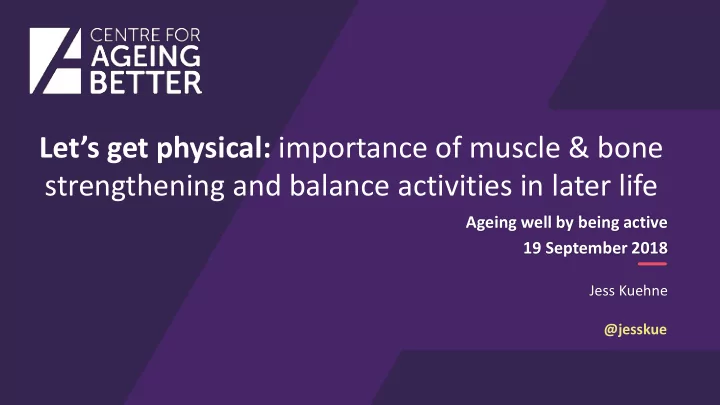

Let’s get physical: importance of muscle & bone strengthening and balance activities in later life Ageing well by being active 19 September 2018 Jess Kuehne @jesskue
What is the current guidance for physical activity? 3
Why is muscle & bone strengthening and balance important? From the age of 40, adults lose 8% of their muscle mass per decade. This increases to 15% per decade once over the age of 70. Source: : Grimby G and Saltin B. The ageing muscle. Clin. Physio. 1983 4
Why is muscle & bone strengthening and balance important? Low muscle strength is linked to a decline in ability to independently carry out activities of daily living. Source: Rantanen, T et al (2002), ‘Muscle strength as a predictor of onset of ADL dependence in people aged 75 years’, Aging Clin Exp Res. 2002 Jun;14(3 Suppl):10-5. 5
Why is muscle & bone strengthening and balance important? Muscle weakness and poor balance in later life are the two most common modifiable risk factors for falls . Source: National Institute for Health and Care Excellence (2015), ‘Falls in older people’ 6
But… Strengthening and balance activities are the ‘ forgotten guidelines ’ of UK Chief Medical Officers’ guidance for physical activity 7
This is reflected in the data… 70% 66% 58% 60% 50% 40% Men 31% 30% Women 23% 20% 13% 10% 10% 0% Adults meeting just aerobic guidelines Adults meeting aerobic & muscle Adults over 65 meeting aerobic & strengthening guidelines muscle strengthening guidelines Source: Health Survey for England (2016) 8
So what activities are most effective and what should individuals be doing? PHE and the Centre for Ageing Better commissioned the UK CMOs’ expert group to undertake a review of muscle and bone strengthening and balance activities (MBSBA). Aims: 1. Review evidence base for MBSBA to improve and protect health and wellbeing. 2. Practical recommendations for how MBSBA can be incorporated into an individual’s life and barriers and enablers 3. Provide practical recommendations for practitioners and other influencers 4. Provide practical recommendations for national surveillance 9
How do muscle & bone strengthening and balance activities vary across the life course? 10
Are there particular ages where strength and balance are most important? - Ages 18 to 24 years to maximise bone and muscle mass gains - Ages 40 to 50 years to maintain strength and slow the natural decline - Over 65 years to preserve strength and balance and maintaining independence. 11
What types of activities are most effective? Type of Sport, Physical Improvement in Improvement in Improvement in Activity or Exercise Muscle Function Bone Health Balance Running x xx x Resistance training xxx xxx xx Circuit training xxx xxx xx Ball Games xx xxx xxx Racquet Sports xx xxx xxx Yoga, Tai Chi x x x Dance x xx x Walking x x 0 Nordic Walking xx NK xx Cycling x x x xxx = Strong effect xx = medium x = low 0 = no effect NK = not known 12
Which strength and balance activities are appropriate for individuals with specific challenges? Type of Sport, Older people Frailer older people * all people with diagnosed Physical Activity or Older adults Osteoporosis with vertebral /Significant cognitive osteoporosis should Exercise (>50 yrs) (OP)* fractures* impairment understand safe lifting of weights (technique and spine Running sparing movement) Resistance training Aerobics, circuit no considerations if training good strength and balance or are practiced in activity Ball games not recommended if Racquet sports naive to the activity (OP or Golf frailer older people) without advice Yoga, Pilates Tai Chi not recommended- potential fracture risk too Dance great 13 Cycling
What are the measurement options for population level surveillance? Existing surveillance studies of physical activity could be supplemented with a small number of objective measures: - Hand grip strength - Walking speed - Chair rise - Standing balance - Timed get up and go 14
Recommendations for specific groups: The public: - Undertake strengthening and balance activities suitable for your physical function and ability at least 2x week - For those at risk of falls or fracture , partake in supervised structured exercise - Undertaking strengthening and balance activities is important at key transition points in life : pregnancy, menopause, onset of/on diagnosis of disease, retirement, on becoming a carer or following hospitalisation 15
Recommendations for specific groups: Practitioners: - Service providers and health professionals should develop approaches that tackle barriers to undertaking strength and balance activities and tailor activities within existing services. - Organisations for health professionals (e.g. royal colleges) and exercise professionals should promote the benefits and risks of strength & balance to their members and users via curriculum, training, resources and materials that support their professional practice and confidence. 16
Recommendations for specific groups: Policymakers: - Commissioners need to: - Recognise the vital role of strength & balance across all the whole population - Recognise that for some specific populations, promotion of strength & balance would be a better option than promoting only aerobic activities - Implement of the Falls & Fractures Consensus Statement - Future physical activity guidelines should give equal weighting to strength and balance activities. - Public messages need to be developed and tested for different segments of the population - A strategy should be developed for capacity building and service delivery - Explore the inclusion of direct and indirect objective measurements within existing national and local surveillance systems 17
Resources Falls and fracture consensus statement: commissioner focussed (but useful to all!). Details key interventions, and approaches to commissioning Falls and fracture consensus statement resource pack: comprehensive set of resources and tools to support commissioning and delivery, including a commissioner’s checklist https://www.gov.uk/government/publica tions/falls-and-fractures-consensus- statement 18
Jess Kuehne jess.kuehne@ageing-better.org.uk @jesskue Centre for Ageing Better Angel Building, Level 3 407 St John Street, London, EC1V 4AD 020 3829 0113 www.ageing-better.org.uk Registered Company Number: 8838490 & Charity Registration Number: 1160741
Recommend
More recommend